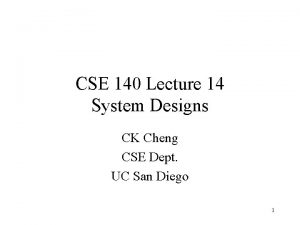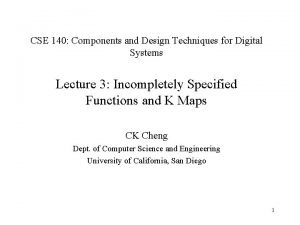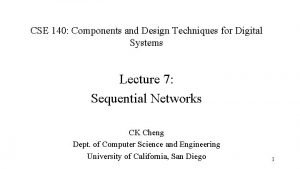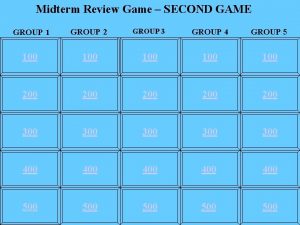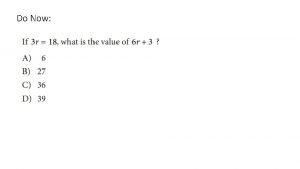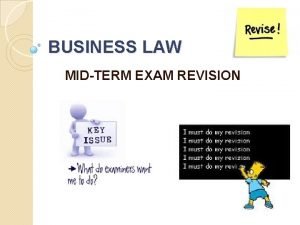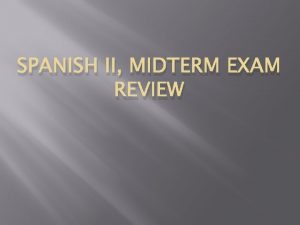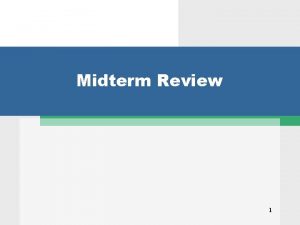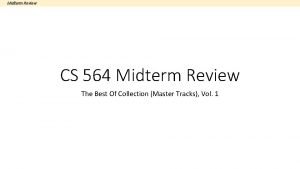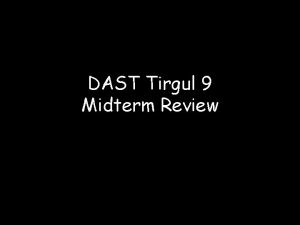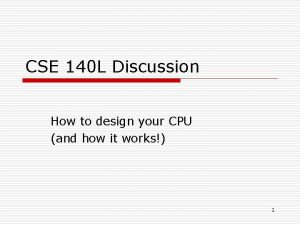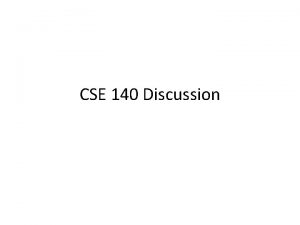CSE 140 Discussion Section Midterm 2 Review Mingjing
















- Slides: 16

CSE 140 Discussion Section Midterm #2 Review Mingjing Chen

Flip-Flops Conversion l Implement a JK flip-flop with a SR flip-flop and a minimal AND-OR-NOT network. JK flip-flop J K Combinational logic S Q R Q’ Solve the combinational logic design problem S = f 1(J, K, Q) R = f 2(J, K, Q)

Flip-Flops Conversion How to attain the specification of the combinational circuit? l S = f 1(J, K, Q) R = f 2(J, K, Q) Truth table for combinational logic J K Q Q’ J K Qprev Q S R 0 0 Qprev Q’prev 0 0 0 1 1 0 x x 0 1 0 0 0 x 1 1 Q’prev Qprev 0 1 1 0 0 1 S R Q Q’ 1 0 0 1 1 0 0 0 Qprev Q’prev 1 0 1 0 1 1 1 0 1 x 1 0 0 1 0 1 1 1 0 0 1 1 1

Flip-Flops Conversion Truth table for combinational logic J K Qprev Q S R 0 0 0 1 1 0 x x 0 0 1 0 0 0 x 0 1 1 0 1 1 0 1 x 1 0 0 1 1 1 0 0 1 Kmap for S JK 00 Qprev 0 0 01 11 10 0 1 1 x 0 0 x 1 S = J Q’prev Kmap for R JK 00 Qprev 0 x 01 11 10 x 0 0 0 1 1 0 1 K J S Q R Q’ R = K Qprev

Sequential Circuit Design l A state machine is described by the following state equations. (1). Write the state table. 2 -bit states: Q 1, Q 0 1 input: x 1 output: y X Q 1(t) Q 0(t) Q 1(t+1) Q 0(t+1 ) y 0 0 0 1 1 0 1 0 0 1 1 1 0 0 1 0 1 1 1 1 0 0 1 1 1 0 1 1

Sequential Circuit Design l Design the system with two JK flip-flops and a minimal AND-OR-NOT network. X Q 1(t) Q 0(t) Q 1(t+1) Q 0(t+1 ) J 1 K 1 J 0 K 0 0 X 1 X x 1 1 X y 0 0 0 1 0 0 1 x 0 0 0 1 1 1 X 0 X 1 1 0 0 X x 0 1 1 0 1 x 0 0 X 1 1 1 0 x 1 x 0 0 1 1 1

Sequential Circuit Design X Q 1(t) Q 0(t) J 1 K 1 J 0 K 0 y 0 0 X 0 X 1 0 0 1 1 X x 1 1 0 x 1 1 X 0 0 1 1 x 0 1 1 0 0 1 X 0 X 1 1 0 X x 0 1 1 1 0 x 0 0 X 0 1 1 1 x 0 1 Kmap for J 0 Q 1 Q 0 00 01 X x 0 0 1 0 x 1 1 0 11 x 10 x x x J 1 = X’Q 0+XQ 0’ Kmap for K 1 Q 1 Q 0 00 01 X x 0 x 1 x x 11 0 10 1 1 0 K 1 = X’ Q 0’+X Q 0 10 1 x 0 J 0 = X’Q 1 Kmap for K 0 Q 1 Q 0 00 01 11 X 1 0 0 x 1 Kmap for J 1 Q 1 Q 0 00 01 X 1 0 0 11 x 0 x K 0 = X’ Q 1’ Kmap for y Q 1 Q 0 00 01 11 X 1 1 0 1 10 0 1 x 1 0 10 x 1 y = Q 1’+Q 0 1 0

Timing l l Circuit implemented using two T flip-flops and a D flip-flop. Timing characteristics: ¡ T flip-flop: l l ¡ D flip-flop: l l ¡ clock-to-Q maximum delay tpcq = 2. 5 ns clock-to-Q minimum delay tccq = 2. 3 ns setup time tsetup = 2. 5 ns hold time thold = 2 ns NAND gate: l l ¡ clock-to-Q maximum delay tpcq = 2 ns clock-to-Q minimum delay tccq = 1. 8 ns setup time tsetup = 1 ns hold time thold = 1. 5 ns propagation delay tpd = 1 ns contamination delay tcd = 0. 8 ns Inverter: l l propagation delay tpd = 0. 5 ns contamination delay tcd = 0. 3 ns

Timing l How many paths? T Q D T Q Q

Timing l 3 paths P 1 T Q P 2 P 3 D T Q Q

Timing l What is the maximum clock frequency of this circuit? P 1: tpcq(D) + tpd(NAND) + tsetup(T) <= clock cycle 2. 5 + 1 <= clock cycle P 2: tpcq(T) + tpd(NOT) + tsetup(D) <= clock cycle 2 + 0. 5 + 2. 5 <= clock cycle P 3: tpcq(T) + tpd(NAND) + tsetup(T) <= clock cycle 2 + 1 <= clock cycle Min cycle = 5 ns max f = 1 / min cycle = 200 MHz

Timing l what is the maximum clock skew that the circuit can tolerate before it might experience a hold time violation? P 1: tccq(D) + tcd(NAND) >= thold(T) + skew 2. 3 + 0. 8 >= 1. 5 + skew P 2: tccq(T) + tcd(NOT) >= thold(D) + skew 1. 8 + 0. 3 >= 2 + skew P 3: tccq(T) + tcd(NAND) >= thold(T) + skew 1. 8 + 0. 8 >= 1. 5 + skew Max skew = 0. 1 ns

Decoder & MUX l three-input Boolean function f(a, b, c) = ∑Pm(1, 2, 4, 7) + ∑ Pd(3) ab c 00 0 0 1 1 01 1 11 0 10 1 x 1 0 f = a’b’c + a'bc’ + abc + ab’c’ + (a’b’c)

Decoder & MUX l Implement the function using a minimal network of 2: 4 decoders and OR gates f = a’b’c + a'bc’ + abc + ab’c’ + (a’b’c) = a’b’c + a'bc’ + abc + ab’c’ c In If inverter is not allowed f = a’b’c + a'bc’ + abc + ab’c’ + (a’b’c) = a’(b+c)+a(b+c)’+bc 0 1 2 s 1 s 03 a b In 0 1 2 s 1 s 03 a b 1 In 0 1 2 s 1 s 03 a 1 In 2 s 1 s 03 b c 0 1

Decoder & MUX l Implement the function using a minimal network of 4: 1 multiplexers. f = a’b’c + a'bc’ + abc + ab’c’ + (a’b’c) = a’b’c + a'bc’ + abc + ab’c’ c c’ 0 1 c’ c 2 3 Out s 1 s 0 a b

Decoder & MUX l Implement the function using a minimal network of 2: 1 multiplexers f = a’c+a’b+bc+ab’c’ = af(1, b, c) + a’f(0, b, c) = a(bc+b’c’) + a’ (b+c) c 0 1 1 s b c’ 0 c 1 s b 0 1 s a
 Cse 140
Cse 140 Cse 140
Cse 140 Cse 140
Cse 140 Ff t
Ff t Pons mnemonic
Pons mnemonic Algebra 1 midterm review
Algebra 1 midterm review Whap midterm review
Whap midterm review Marketing midterm review
Marketing midterm review Global 9 midterm review
Global 9 midterm review Trig midterm review
Trig midterm review Chemistry midterm review
Chemistry midterm review Business law midterm
Business law midterm Apes midterm review
Apes midterm review Ap chemistry midterm exam
Ap chemistry midterm exam Algebra 2 midterm exam
Algebra 2 midterm exam Spanish 2 midterm review
Spanish 2 midterm review Mid term test english 10
Mid term test english 10
